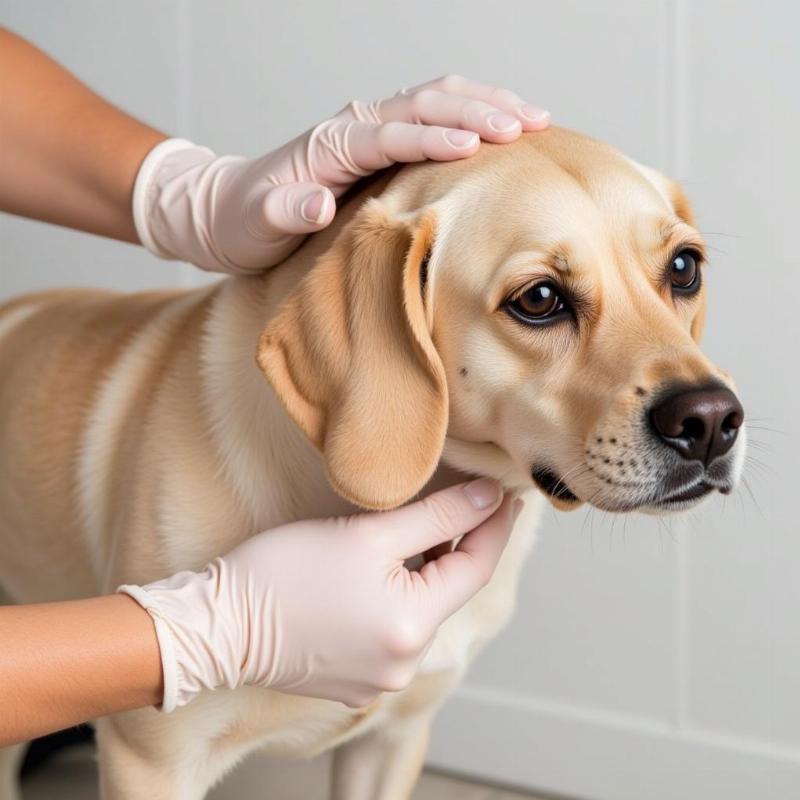Clotrimazole for dog yeast infections is a common topic among pet owners in the US. Yeast infections, medically known as Malassezia dermatitis, can cause significant discomfort for our canine companions. If you suspect your dog has a yeast infection, you’re likely looking for safe and effective treatment options. This comprehensive guide will delve into using clotrimazole for dog yeast infections, covering everything from symptoms and causes to application and potential side effects.
Understanding Yeast Infections in Dogs
Yeast is a naturally occurring fungus found on a dog’s skin. However, under certain conditions, like allergies, excessive moisture, or a weakened immune system, this yeast can overgrow, leading to a yeast infection. These infections commonly appear in warm, moist areas like the ears, paws, skin folds, and armpits. Symptoms include redness, itching, a musty odor, and sometimes a greasy or scaly appearance on the affected skin.
Can I Use Clotrimazole on My Dog?
Clotrimazole is an antifungal medication commonly used to treat yeast infections in humans. While it’s available over-the-counter, it’s crucial to consult with your veterinarian before applying clotrimazole to your dog. Although it can be effective, some dogs may be sensitive to it, and using the wrong concentration or formulation could worsen the condition. Your vet can confirm the diagnosis and recommend the appropriate form and dosage of clotrimazole. Never self-treat, especially if your dog has a history of allergies or other medical conditions.
Clotrimazole Cream for Dogs Yeast Infection
Clotrimazole cream is a topical application often prescribed for localized yeast infections. Your vet will guide you on how much cream to apply and how often. Typically, a thin layer is applied to the affected area twice daily. Ensure the area is clean and dry before application. It’s essential to prevent your dog from licking the treated area, as ingesting clotrimazole can cause stomach upset. Consider using an Elizabethan collar (cone) to prevent licking.
 Applying Clotrimazole Cream to a Dog
Applying Clotrimazole Cream to a Dog
Clotrimazole Cream for Dogs Ears
Yeast infections are particularly common in dogs’ ears due to the warm, moist environment. If your vet diagnoses an ear infection, they might recommend clotrimazole ear drops or a cream specifically formulated for ears. Follow their instructions carefully, as applying the wrong medication or incorrect dosage can damage the eardrum.
Other Treatment Options for Dog Yeast Infections
Besides clotrimazole, other antifungal medications are available for treating yeast infections in dogs, such as ketoconazole and miconazole. Your veterinarian may also recommend medicated shampoos, wipes, or oral antifungal medications depending on the severity and location of the infection.
Addressing Underlying Causes
Treating the yeast infection is only part of the solution. It’s crucial to address any underlying causes, such as allergies or hormonal imbalances, to prevent recurrence. Your veterinarian can help determine the underlying cause and recommend appropriate management strategies.
Conclusion
Clotrimazole can be a helpful tool in treating dog yeast infections, but it’s crucial to consult your veterinarian before using it. They can confirm the diagnosis, recommend the appropriate formulation and dosage, and address any underlying conditions contributing to the infection. Proper diagnosis and treatment are essential for your dog’s comfort and well-being.
FAQ
-
How can I tell if my dog has a yeast infection? Look for redness, itching, a musty odor, and sometimes a greasy or scaly appearance on the skin, particularly in warm, moist areas.
-
Is clotrimazole safe for all dogs? While generally safe, some dogs may be sensitive. Always consult your veterinarian before use.
-
Can I use human clotrimazole cream on my dog? It’s best to use a veterinary-approved product. Consult your vet for guidance.
-
How long does it take for clotrimazole to work? Improvement is often seen within a few days, but continue treatment as directed by your vet.
-
What if the infection doesn’t clear up? Consult your vet, as a different medication or approach may be necessary.
-
Can diet affect yeast infections? Yes, certain foods can exacerbate yeast overgrowth. Your vet can recommend dietary changes.
-
How can I prevent yeast infections in my dog? Keep your dog dry, especially in skin folds, manage allergies, and maintain a healthy immune system.
Related Articles:
- clotrimazole cream for dogs yeast infection
- gentacalm topical spray for dogs uses
- clotrimazole cream for dogs ears
- can i put clotrimazole on my dog
Beautdogs.us is your premier resource for all things dog-related in the US. We provide expert advice on dog breeds, grooming, health, and nutrition, offering comprehensive guidance for both novice and experienced dog owners. Our team of veterinary experts and breed specialists are dedicated to helping you provide the best possible care for your canine companion. From product reviews to training tips, Beautdogs.us is your trusted source for navigating the world of dog ownership. Contact us for personalized support at [email protected] or +1 501-555-7529.